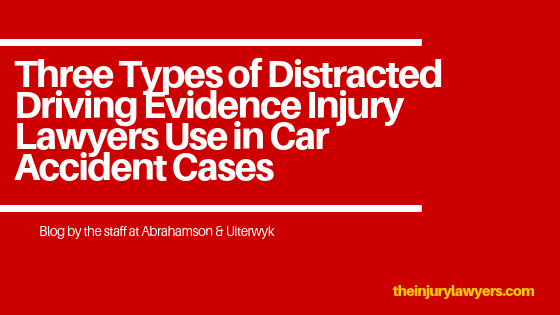
If you are like most drivers, you do everything that you can to keep yourself, your passengers, and your fellow drivers safe when you are on the road.
Unfortunately, it only takes a moment of inattention for a distracted driver to make a mistake that can seriously hurt innocent people. When that happens, personal injury lawyers 0ften need to provide evidence showing what had distracted the at-fault driver at the time of the accident.
The types of distracted driving evidence that a car accident lawyer may use varies depending on the nature of the case. Below are three of the more common types of evidence that an injury law team may look for.
Distracted Driving Evidence at the Scene of the Accident
In many cases, one or more individuals are able to have claimed that they witnessed a driver who was distracted while using a mobile device at the time of an accident. Injury victims themselves may have seen that the driver was clearly talking or texting on a device immediately before an accident.
In other cases, witnesses, including individuals riding with the at-fault driver, come forward to confirm that the driver was distracted to the point of negligence. This is one of the reasons that it is so important to file a police report and obtain contact information from witnesses immediately after an accident.
Proving Distracted Driving through Cell Phone Records
Of course, injury victims have obtained meaningful evidence that a driver was distracted with a mobile device when they are at the scene of the accident itself. Instead, a personal injury lawyer can get the distracted driving evidence necessary to at least partially prove fault by obtaining the at-fault driver’s mobile phone records.
In many cases, the most important information for a case in a negligent driver’s phone records include call logs, text messages, and time-stamped data usage from the day of the collision.
Gathering Evidence from Event Data Recorders
Many modern vehicles are equipped with event data recorders (EDRs) that record various information that can be very helpful when investigating a collision. Some of the relevant information captured by EDRs include accelerator pedal position, vehicle speed, brake pedal position, and the change in velocity at the time of an accident.
When it comes to a distracted driving investigation, the National Highway Traffic Safety Administration notes that data captured by an EDR can help explain the action or lack of action a driver took in the events leading up to a collision. These records can be matched up with non-electronic evidence of distracted driving recorded by law enforcement or rescue personnel, such as makeup, reading materials, electronic devices, or other distracting materials found at the scene.
In recent years, distractions like texting while driving have become an epidemic in Florida.
If you or a loved one has been seriously injured in a distracted driving accident, our injury law team may be able to help. Call Abrahamson & Uiterwyk today for a free case evaluation.
